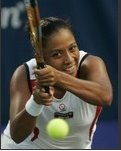Showing posts with label The New York Times. Show all posts
Welcome Tennis Lovers!!
...
The New York Times: Garrison Isn't Backing Down From Lawsuit
Thursday, July 2, 2009
 WIMBLEDON, England — Zina Garrison’s racial discrimination lawsuit against the United States Tennis Association has largely been panned in the greater American tennis community as without merit, based on her mediocre record as the United States’ Fed Cup captain from 2004 to 2008.
WIMBLEDON, England — Zina Garrison’s racial discrimination lawsuit against the United States Tennis Association has largely been panned in the greater American tennis community as without merit, based on her mediocre record as the United States’ Fed Cup captain from 2004 to 2008.But in an interview Wednesday afternoon after playing in a Ladies’ Invitation Doubles match, she said she was not backing down from, and had no intention of dropping, the suit.
“What I’ll say is that it’s not what it is being made out to be,” she said. “I’m still the same person people always knew. I’m still an honest and truthful person.”
Garrison was fired after posting a 5-5 record as captain and failing to lead a nation that had been a longtime Fed Cup power to even one final, replaced by Mary Joe Fernandez. She filed the suit last February in a Manhattan federal court. It charged, among other things, different pay scales and treatment for her and Patrick McEnroe, the American Davis Cup captain, who has won one Davis Cup and had more success in getting the best American players — mainly Andy Roddick — to participate.
Her stance is that her tenure as captain began as American stars — Monica Seles and Jennifer Capriati — were departing the sport, and Lindsay Davenport, a standby when Billie Jean King was captain, was tiring of the commitment. That left Venus and Serena Williams as the only imposing American players.
Venus Williams, a good friend of Garrison’s, often committed, but Serena Williams seldom played.
Asked if she believes, in retrospect, that she, as an African-American, was hired to entice the Williams sisters to play and not based on her coaching ability, Garrison nodded. Hence, her charge of racial discrimination, given her belief that her job security was largely based on the U.S.T.A.’s expectation that African-American players would come through for an African-American captain.
“That’s pretty accurate,” Garrison said.
Read the rest of this post...........
Posted by Shelia at 11:22 PM Labels: Harvey Araton, Lawsuit, The New York Times, Zina Garrison Email this post
NY Times: A Day Out With Serena Williams - Denim Is A Tough Opponent
Sunday, April 26, 2009
IT’S hard enough for most people to find the perfect pair of jeans, but imagine being Serena Williams. Her muscular 5-foot-9-inch frame is a blessing on the tennis court but a curse in the fitting room, where her curves turn every shopping excursion into an odyssey.
“First I look for the size,” said Ms. Williams, 27, explaining that her posterior was on the large side. She rifled through stacks of denim at a Joe’s Jeans counter at Barneys New York; a salesman handed her a new, slimming cut to try.
“Oh, these are for short girls,” she said wearily, unfurling the pair. “These would be like shorts on me. They would be like a bikini on Venus.” (Her sister, Venus Williams, is 6-foot-1).
That afternoon, Ms. Williams had escaped her busy schedule of training for the French Open and promoting charities to indulge in a shopping jaunt in New York City, accompanied by Nikki Burchiere, her personal assistant. Lunch was a sidewalk-vendor pretzel wolfed on the escalator at Barneys.
Ms. Williams, the reigning United States Open champion, was looking for jeans, yes, but also for inspiration for her new fashion line, Serena Williams Signature Statement, which she said she was active in designing. Her jewelry and handbags, all under $100, will be introduced this month on HSN.
Thumbing through the racks in Rag & Bone, Ms. Williams discussed her latest design theories. “Modern buildings can be really influential — the shape, the structure,” she said, pointing to the sleek, Le Corbusier-like geometry of a gray tunic dress. “I’m not saying this was influenced by a building, but it easily could be, these lines here.”
Fashion has long been a big part of Ms. Williams’s identity, as when she flummoxed tennis traditionalists by showing up for the United States Open in a black Lycra catsuit. Since then she has become a Cher of the tennis court, serving aces in pink hot pants, punky denim, even a studded leather jacket that looked more appropriate for a Judas Priest concert. “I’m a performer,” Ms. Williams said, by way of explanation.
But off court, “you wouldn’t believe how plain I am,” she said, wearing a simple white T-shirt and black leather jacket. “I’m a plain Jane.” (Ms. Burchiere felt compelled to point out that her boss owns more than 300 pairs of shoes.)
Fashion is more than a marketing vehicle for her, she said. It also provides a mental release from tennis, which is a 9-to-9 job for 11 months a year. A lot of her time is spent in hotel rooms watching reality TV and scribbling designs in her ever-present sketch pad, she said.
“I’m a loner on the tour,” Ms. Williams said. “When I was growing up, I idolized Monica Seles and Steffi Graf, and when you get on tour, you see that these people stick to themselves.”
Eventually, Ms. Williams disappeared into a dressing room with a stack of jeans. She emerged minutes later looking defeated. “Nothing fit,” she said, not even the ones with the promising labels that read “booty” and “curvy.”
“I guess I’ll just have to design my own,” she said.
Read the rest of this post...........
Posted by Shelia at 12:26 AM Labels: Alex Williams, Barney's, Daniel Barry, Judas Priest, Le Corbusier, Monica Seles, Nikki Burchiere, Rag And Bone, Serena Williams, The New York Times, Venus Williams Email this post
The NY Times: U.S. Tennis Losing Ground In Developing Players
Saturday, April 4, 2009
By NEIL AMDUR
At a time when recreational tennis is on the rise in the United States an emphasis is being placed on recruiting youngsters, Americans are conspicuous by their absence in the late-round singles draws at most professional tournaments.
Officials of the United States Tennis Association say junior development has never been more organized, with national and regional training centers, dozens of former pros as salaried coaches (with Patrick McEnroe as the general manager of elite player development) and a serious commitment to finding future champions.
“There’s no secret formula, and that’s our strength,” says Martin Blackman, a former touring pro, college coach and now the senior director for talent identification and development with the U.S.T.A. He acknowledges a “paradigm shift in the late ’80s” that opened opportunities for players in Eastern Europe and in Latin America.
“What we’re doing at the national level now is complementary and inclusive,” Blackman said.
But critics like Robert Lansdorp, the California stroke guru, and Pete Fischer, who developed Pete Sampras’s serve and his tactical all-court game, say the focus is misguided.
“Everything is fragmented,” Fischer said during a recent telephone interview from California, citing conflicting coaching techniques and different competitive priorities as inhibitors to producing champions. “I don’t see one vision. The U.S.T.A. is graded on how their players do in I.T.F. events. Who cares about that? Short-term goals get in the way of long-term goals.”
Lansdorp, who prefers one-on-one coaching to academy and training centers, said he talked to McEnroe recently.
“He has the right ideas,” Lansdorp said, “but you don’t get a champion out of a group. You have to find talent. And then you have to develop that talent.”
In a phone interview, McEnroe acknowledged the appointment of José Higueras as a national director of coaching.
“The No. 1 important thing is to get a coaching philosophy in place for our program,” McEnroe said.
Of the top 100 ranked players on the WTA Tour as of March 23, only four were American, and two were in the top 10, the Williams sisters, Serena (No. 1) and Venus (No. 6). (The other two were No. 37 Bethanie Mattek-Sands and No. 85 Jill Craybas.) By contrast, 14 Russian women were ranked among the top 100, including 10 in the top 50 and five among the top 10.
The situation is little better on the ATP men’s tour. Spain has 14 players among the first 100, including at No. 1. France has 13. Of the seven Americans in the top 100, only one, Andy Roddick (No. 6), is in the top 10.
Ten years ago, four American women were in the top 10, and 15 among the top 100. Three men from the United States were in the top 10, and 12 in the top 100.
Historically, American tennis champions have developed through a combination of player skill and drive, parental pride and persistence, and the technically sound acumen of a dedicated coach.
For all of his eccentric off-court pronouncements, Richard Williams recognized his daughters’ natural gifts and work ethic, and extracted mechanical refinements and support from a number of quality coaches (Rick Macci and Nick Bollettieri, to name a few). The result: the Williams sisters have combined for 17 Grand Slam singles titles in the last 10 years.
Bollettieri, whose tennis academy in Florida produced Andre Agassi and Jim Courier among others, said players had to be ready to work 365 days a year.
“This is what it takes to be successful in tennis in America,” he said.
The latest examples of works in progress reflect the scope of the search.
Victoria Duval, 13, whose family is from Haiti, won the U.S.T.A. National 14s last year. She lives with her mother and grandmother in Bradenton, Fla., near Bollettieri’s academy, now owned by IMG Academies. Madison Keys, 14, was a finalist in the Orange Bowl 16s, and is scheduled to make her pro debut Monday at a WTA event in Ponte Vedra, Fla.
The Williams sisters played a limited age-group schedule until the age of 14 and tailored their tournament commitments. That may explain why they still have a competitive zest while other No. 1 pros like Justine Henin, Kim Clijsters and Martina Hingis left the game before turning 25. Clijsters is planning a comeback.
The notion that young Americans won’t pay the same price for success as Russians, Serbs or other Europeans — long hours on the court, weeks away from home, fighting through competitive qualifiers or satellite events in less-attractive places — is as much a topic for debate as whether United States tennis is losing the biggest and best athletes to college scholarships in basketball, soccer and even lacrosse.
“Kids should learn to play tennis exactly the way they learn to play basketball,” said Ray Benton, a lawyer based in Washington who has been involved in the sport for decades as a player, promoter and entrepreneur. He is now the chief executive of a regional training center in College Park, Md.
Recreational recruitment is growing. QuickStart Tennis, a format for three age levels announced last year, is in 1,200 facilities, according to the U.S.T.A. The youngest, 5 to 8, play on a 36-foot court with a foam tennis ball. For preteens, the court is expanded to 60 feet with low-compression balls. The third level plays on the standard court.
“You’re going to see a dramatic improvement in our junior players between 13 and 18 in three years,” Blackman said.
Pancho Segura, who is considered a tactical Yoda in the sport, seems more skeptical. Too many young Americans, Segura said, are using extreme Western-style grips, which yield tantalizing topspin but inhibit an ability to slice, volley and adequately cover low balls.
More important, he added, “They don’t know how to win tennis matches.”
Read the rest of this post...........
Posted by Shelia at 10:47 PM Labels: Martin Blackman, Patrick McEnroe, Pete Fischer, Pete Sampras, Robert Lansdorp, Serena Williams, The New York Times, USTA, Venus Williams Email this post
Beautiful Front Pages For The Ages
Thursday, November 6, 2008
Posted by Shelia at 1:54 AM Labels: The New York Post, The New York Times, The Wall Street Journal, The Washington Post Email this post
Subscribe to:
Comments (Atom)






















































































![Validate my Atom 1.0 feed [Valid Atom 1.0]](valid-atom.png)
